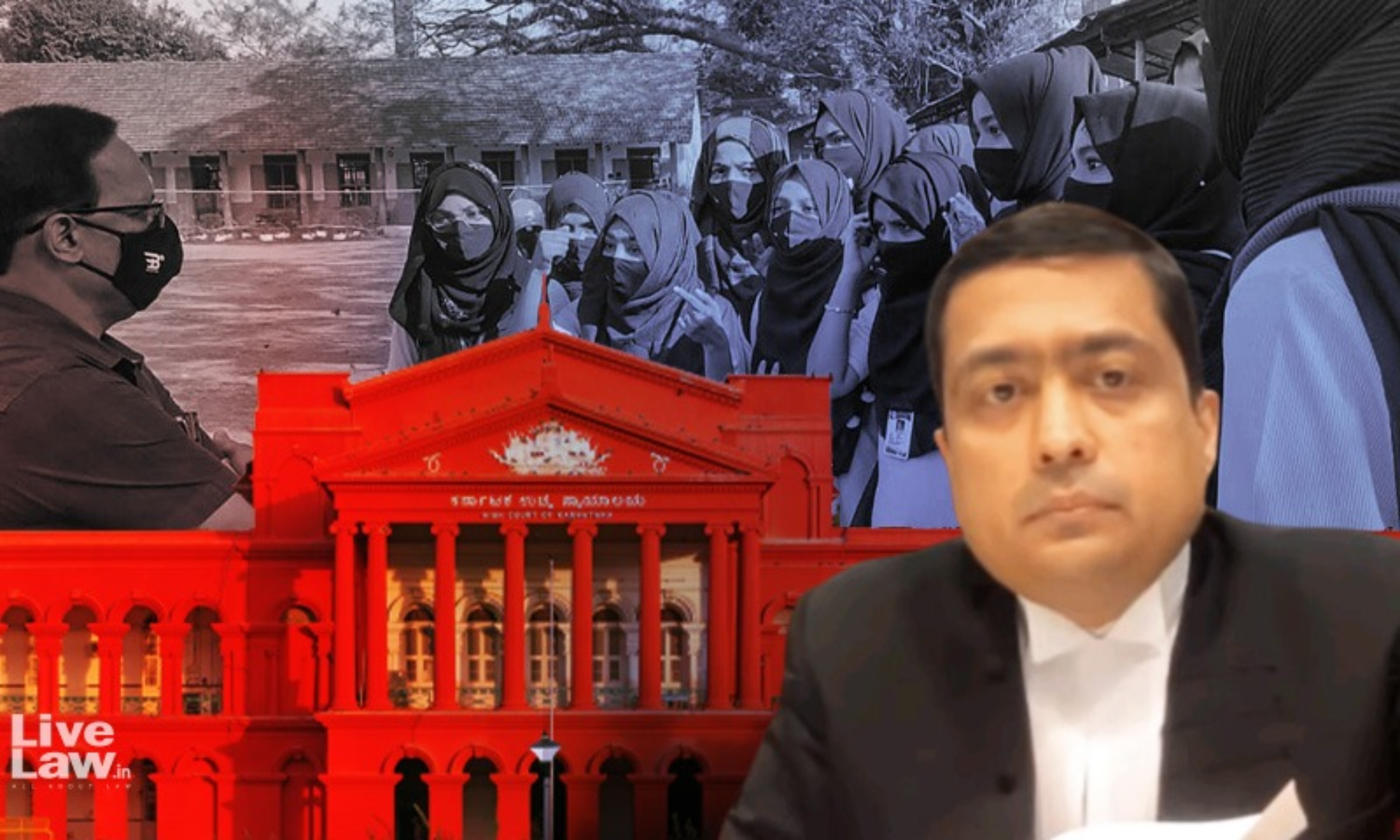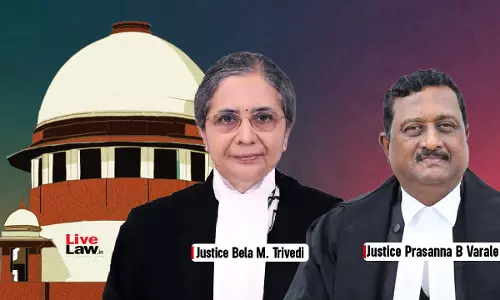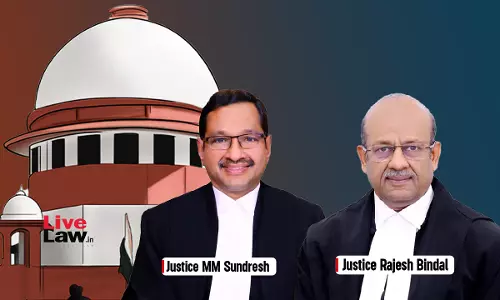Hijab Ban: South African Judgment Allowing Hindu Girl To Wear Nose Ring In School As Cultural Practice Cited Before Karnataka HC

A Full Bench of the Karnataka High Court on Tuesday heard extensive arguments on behalf of the petitioners, Muslim girl students, who challenged the action of a government college in denying their entry for wearing a hijab (headscarf).Senior Advocate Devadatt Kamat appearing for the petitioners argued that wearing Hijab is an essential religious practice under Islam, and suspension of the...
A Full Bench of the Karnataka High Court on Tuesday heard extensive arguments on behalf of the petitioners, Muslim girl students, who challenged the action of a government college in denying their entry for wearing a hijab (headscarf).
Senior Advocate Devadatt Kamat appearing for the petitioners argued that wearing Hijab is an essential religious practice under Islam, and suspension of the same, even for a few hours during school, undermines the community's faith and violates their fundamental rights under Article 19 and 25 of the Constitution.
The Bench comprising Chief Justice Ritu Raj Awasthi, Justice Krishna S Dixit and Justice JM Khazi also heard Prof Ravivarma Kumar, Senior Advocate, appearing for the petitioner in a connected case.
Yesterday, Kamat had underscored that the declaration made by the State government that wearing of headscarf is not protected by Article 25 of the Constitution was "totally erroneous'. It was also submitted that the conduct of the State government in delegating to the College Development Committee (CDC) to decide whether to allow headscarfs or not is 'totally illegal'.
Last Friday, the Full bench had restrained students from wearing any sort of religious clothes in classrooms, regardless of their faith, while the matter is pending hearing. The interim order is only applicable to those institutions which have prescribed a uniform dress code.
Today, it was also brought to the attention of the Court that the interim order is purportedly being misused. "Muslims girls are forced to remove their hijab. In Gulbarga, govt officials went to an Urdu school and forced the teachers and students to remove hijab," Advocate Mohammed Tahir alleged.
However, the Bench rejected the application made in this regard by Tahir, stating that an Advocate cannot file an affidavit.
Kannada word used in GO means "Public Order"
Kamat started his arguments by clarifying that the Kannada word used in the Government Order "sarvajanik suvyavasthe" means public order. Yesterday, the Advocate General had submitted that the word does not mean "public order" and that the petitioner has inaccurately translated it. Today, Kamat pointed out that the same word is used in the Kannada translation of the Constitution for "public order" wherever it is used. Hence, he argued that the State is seeking to invoke "public order" ground in the GO.
Justice Dixit then observed that a GO cannot be read like a statute or a Constitutional provision.
State can't curb only curb an abhorrent religious practice
At the outset, Kamat argued that the State cannot, by passing an Education Act, curb the religious beliefs of a community. He referred to the case of Sardar Syedna Taher v. State Of Bombay where the Supreme Court had struck down a Bombay law which prohibited ex-communication from a community, on petitions by Bohra members. The Supreme Court had held therein that if it is an essential religious practice, it must be upheld.
"What flows from this judgment is that the guidance to State in stopping religious practice is it should be which is abhorrent having a deleterious effect on society. In this case, it is an innocuous practice of wearing head scarf...The essence of Article 25 is that it protects the practise of faith but not a mere display of religious identity or jingoism," Kamat said.
Kamat submitted that wearing of religious articles was a common practice in India have social approval.
"When I was in school and college I used to wear rudraksha. It was not to display my religious identity. It was a practice of faith because it gave me security. We see many judges and senior lawyers wearing such customary things", he submitted.
As regards bhagwa shawls, Kamat submitted that the relevant consideration was if it was only to counter another religious practice or if it was rooted in genuine religious faith.
"To counter that, if somebody wears a shawl, you will have to show that is it a display of religious identity alone or is it something more. If it is sanctioned by Hinduism, by our Vedas or Upanishads then the court is duty-bound to protect it", he argued.
In support of his case, Kamat heavily relied on a judgment of the Constitutional Court of South Africa, in KwaZulu-Natal and Others v Pillay, pertaining to the right of a Hindu girl from South India to wear a nose ring.
It was the girl's case that wearing nose ring was a part of long standing tradition in South India. However, the State had argued that the girl had agreed to the school code. Further, she was free to wear it outside the school, and hence, removing the same for few hours during school does not impact her culture.
Kamat submitted that similar arguments have been made by the Karnataka government in this case. "Will heavens fall if you don't wear Hijab for few hours in school, they ask."
However, he emphasized, the South African Court had held that preventing her from wearing the nose ring for several hours of each school day would undermine the practice and therefore constitute a significant infringement of her religious and cultural identity.
Kamat quoted from the judgment :
"What is relevant is the symbolic effect of denying her the right to wear it for even a short period; it sends a message that Sunali, her religion and her culture are not welcome...Persons who merely appear to adhere to a religious and/or cultural practice, but who are willing to forego it if necessary, can hardly demand the same adjustment from others as those whose identity will be seriously undermined if they do not follow their belief."
Highlighting the SA court's observations that the restriction will send a message that the petitioner and her culture were not welcome in the country, Kamat submitted, "I don't want to say anything more. See how beautifully the Court puts it. That you can't send a message to someone in the community that a particular religion or culture is not welcome. That should not be the approach of the Court".
Kamat further argued that the present case is not about constitutionality of the school uniform, but it's about whether a certain exemption, accommodation can be given to students exercising religious faith, to wear an extra cloth of the same color as the uniform.
In this regard, he referred to an observation made by the South African Court, "Granting exemptions will also have the added benefit of inducting the learners into a multi-cultural South Africa where vastly different cultures exist side by-side."
Kamat then submitted that the apprehensions expressed by the State regarding other students flouting school uniform and discipline, was also raised before the South African Court. However, it was held therein that there is no merit in such an argument.
"This judgment applies only to bona fide religious and cultural practices...The possibility for abuse should not affect the rights of those who hold sincere beliefs if there are other learners who hitherto were afraid to express their religions or cultures and who will now be encouraged to do so, that is something to be celebrated, not feared...the more learners feel free to express their religions and cultures in school, the closer we will come to the society envisaged in the Constitution. The display of religion and culture in public is not a "parade of horribles" but a pageant of diversity which will enrich our schools and in turn our country."
Kamat also submitted that the Court rejected the argument that allowing nose-stud will have an adverse impact on discipline.
"There is no reason to believe, nor has the School presented any evidence to show, that a learner who is granted an exemption will be any less disciplined or that she will negatively affect the discipline of others", the Court had noted in that case.
South African court noted that Sunali had been wearing nose-studs for two years and did not create any adverse effect on the school discipline.
"This is what the Chief Justice asked me, whether they have been wearing the headscarves. Yes, they have been wearing and the students were following the school discipline", Kamat submitted drawing parallels from the SA judgment.
Kamat also referred to another South African judgment allowing Rastafarians to keep dreadlocked hair in school and a Canadian judgment allowing a Sikh student to wear kirpan in schoo.
Hecklers Veto cannot be allowed: Kamat
"This is an innocuous practise of wearing head scarf and not changing my uniform. This is a facet of freedom of speech and expression. If small exemption is given to wear headscarf, it will be in line with right to freedom of speech and expression."
Kamat submitted that the sweep of the interim order is extremely brord, and it is in the teeth of Article 25 and other rights. "Kindly make some leeway. In the meanwhile permit us to wear the head scarf in addition to uniform. Consideration will take time. This order in effect suspends fundamental rights. Kindly do not continue this interim order," he urged.
Explusion for not wearing uniform impermissible
He further contended that the Education Act has no provision to expel a student for not adhering to uniform. "If you are not allowing entry for an extra attire, doctrine of proportionality will come in", Kamat argued.
The Chief Justice asked if the students have been expelled. Kamat replied that they are not allowed to enter.
Saying that expulsion was different from denial of entry, Justice Dixit then asked, "A passenger not allowed entry in a train because of not having a ticket...how is that covered under doctrine of proportionality?"
"Not allowing inside the classroom or school has the same consequences", Kamat submitted.
Arguments by Sr Adv Ravivarma Kumar
Kumar pointed out that the students were prevented from entering the school from December 28. However, the State has been banking upon a decision taken on December 31. He further stated that the State has spoken about "code of conduct of institution"; whereas there is no code of conduct.
"Kindly mark this Govt is yet to take a decision on the uniform dress code. It is to constitute a high-level committee. As of now Govt has not prescribed any uniform or prohibited the wearing of hijab."
Kumar further submitted that the Education Act is a complete code in itself, and the so-called College Development Committee does not find mention under the statute. "It is an extra-legal authority which is now endowed with the power to prescribe the uniform, contrary to the scheme of the act and letter of the rules," he argued.
Case so far
It is the petitioner's case that the right to wear hijab is an essential religious practice under Islam, and the State is not empowered to interfere with such rights under Article 14,19 and 25 of the Constitution.
Meanwhile, the State has claimed that it's aim is not to interfere with the religious beliefs of any community but, is only concerned to maintain uniformity, discipline and public order in educational institutions.
"The feeling of oneness, fraternity and brotherhood shall be promoted within an institution. In educational institutions, students should not be allowed to wear identifiable religious symbols or dress code catering to their religious beliefs and faith. Allowing this practice would lead to a student acquiring a distinctive, identifiable feature which is not conducive for the development of the child and academic environment," it submitted in a written reply.
The matter was first listed before a single bench of Justice Krishna S. Dixit, which referred the petitions to larger bench observing that "questions of seminal importance" are involved.
On Friday, the Full Bench after hearing both sides passed an interim order restraining the students from wearing any sort of religious clothes in classrooms, regardless of their faith, till disposal of the matter.
(Edited and compiled by Akshita Saxena)
Live Updates of the hearing available here.
Live Stream of the hearing available here :




